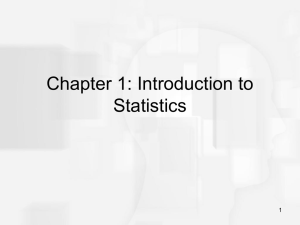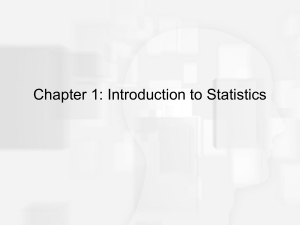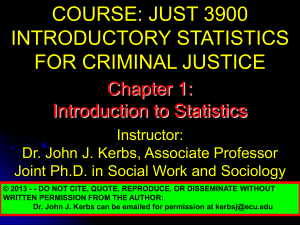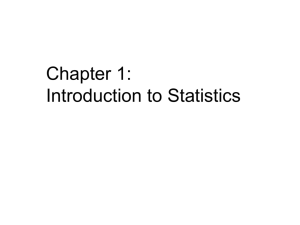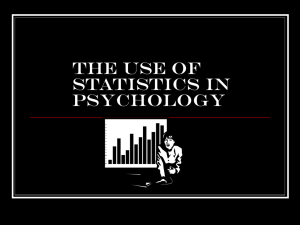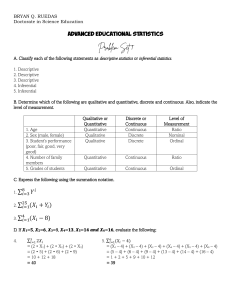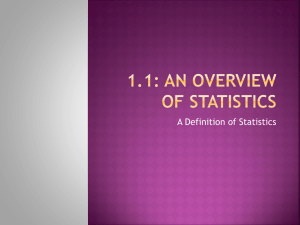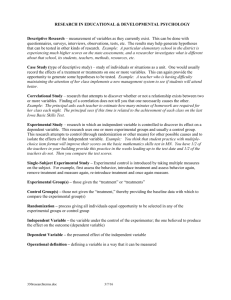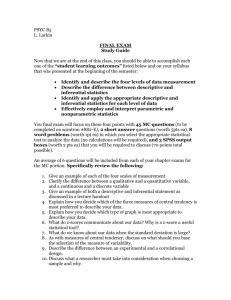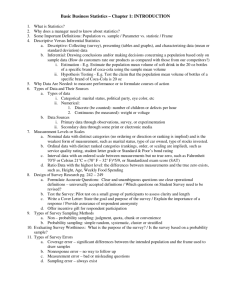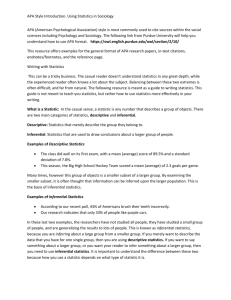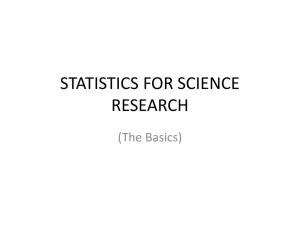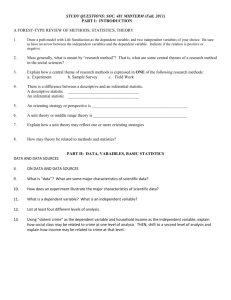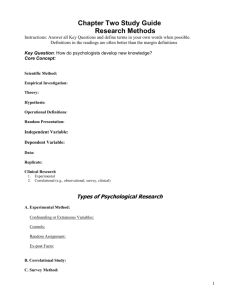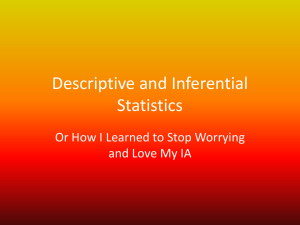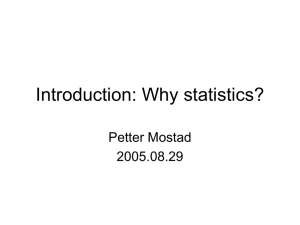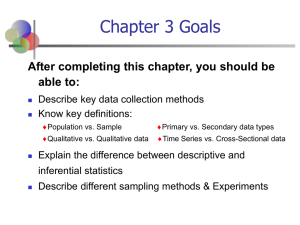Intro to Stats
advertisement
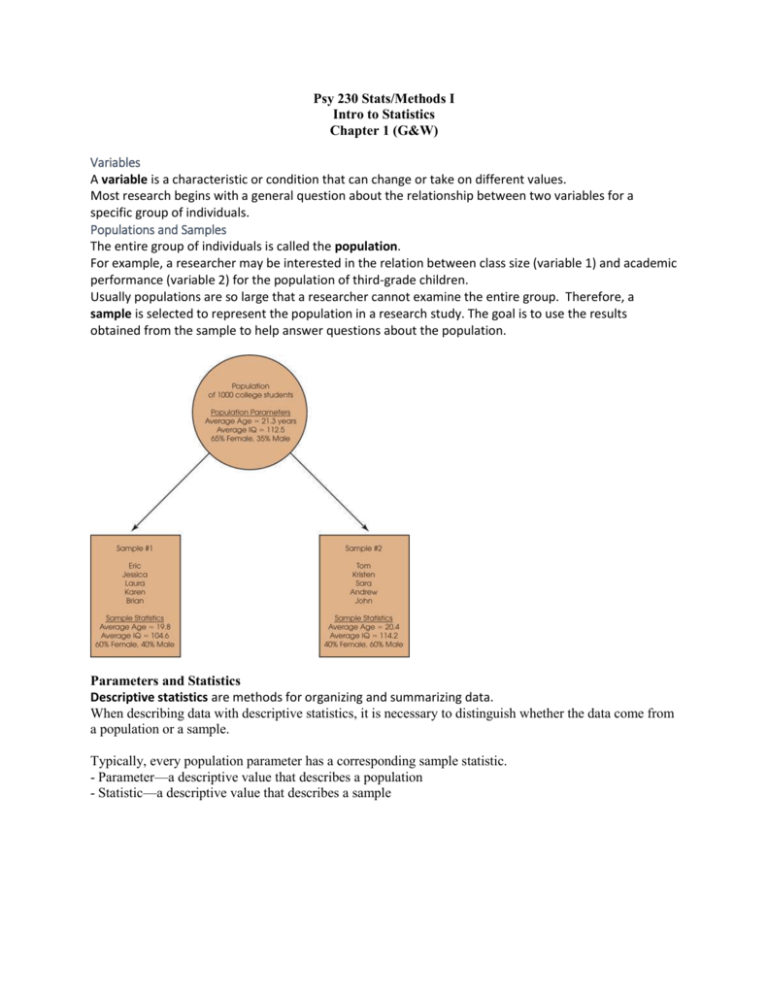
Psy 230 Stats/Methods I Intro to Statistics Chapter 1 (G&W) Variables A variable is a characteristic or condition that can change or take on different values. Most research begins with a general question about the relationship between two variables for a specific group of individuals. Populations and Samples The entire group of individuals is called the population. For example, a researcher may be interested in the relation between class size (variable 1) and academic performance (variable 2) for the population of third-grade children. Usually populations are so large that a researcher cannot examine the entire group. Therefore, a sample is selected to represent the population in a research study. The goal is to use the results obtained from the sample to help answer questions about the population. Parameters and Statistics Descriptive statistics are methods for organizing and summarizing data. When describing data with descriptive statistics, it is necessary to distinguish whether the data come from a population or a sample. Typically, every population parameter has a corresponding sample statistic. - Parameter—a descriptive value that describes a population - Statistic—a descriptive value that describes a sample Descriptive Statistics vs. Inferential Statistics Descriptive Stats techniques used to summarize, organize, and simplify data can't look at it all - get a quick, good impression Inferential Stats techniques used to study samples and then make generalizations about the populations from which they were selected. Use sample statistics to make inferences about the corresponding population parameters. A drawback? Sampling Error The discrepancy between a sample statistic and its population parameter is called sampling error. Defining and measuring sampling error is a large part of inferential statistics. Variables discrete - separate categories. No values can exist between two neighboring categories (e.g., dice) continuous - infinite fineness. There are an infinite number of possible values that fall between any two observed values • For example, time can be measured to the nearest minute, second, half-second, etc. - each score corresponds to an interval of the scale - the boundaries that separate these intervals are called real limits Measuring Variables To establish relationships between variables, researchers must observe the variables and record their observations. This requires that the variables be measured. Scales of Measurement The process of measuring a variable requires a set of categories called a scale of measurement and a process that classifies each individual into one category. Four Types of Measurement Scales: Nominal - discrete categories The categories represent qualitative differences in the variable being measured. Can only determine same or different Ordinal - ordering or ranking Often consists of a series of ranks or verbal labels The categories form an ordered sequence Can determine direction of difference between two individuals Interval - how far apart on a given dimension Categories are ordered sequentially, and all categories are the same size Can determine direction AND magnitude of a difference Arbitrary zero point---zero does NOT mean a complete absence of the attribute being measured (e.g., °F, IQ) Ratio - an interval scale with an absolute zero point Equal, ordered categories and the value 0 means a complete absence of the variable being measured (e.g., height in inches, weight in lbs.) Can determine direction and magnitude of a difference and ratio comparisons make sense Correlational Studies The goal of a correlational study is to determine whether there is a relationship between two variables and to describe the relationship. Correlation coefficient quantifies degree and direction of relationship A correlational study simply observes the two variables as they exist naturally. Experiments The goal of an experiment is to demonstrate a cause-and-effect relationship between two variables; that is, to show that changing the value of one variable causes changes to occur in a second variable. In an experiment, one variable is manipulated to create treatment conditions. A second variable is observed and measured to obtain scores for a group of individuals in each of the treatment conditions. The measurements are then compared to see if there are differences between treatment conditions. All other variables are controlled to prevent them from influencing the results. The manipulated variable is called the independent variable and the observed variable is the dependent variable. 4 characteristics of true experiments: 1 – MANIPULATION 2 – MEASUREMENT 3 –COMPARISON 4 – CONTROL Now try the Experimental Design Exercise Difference between an experiment and quasi-experiment? Quasi-experiments aim to establish a tentative cause and effect relationship between two variables but cannot satisfy all of the strict requirements needed for a true experiment (often cannot not meet all of the above requirements in a natural settings). Introduce some treatment or manipulation. Uses some of the rigor and control used in true experiments. But in some way, lack the control found in true experiments (usually lack random assignment of participants to conditions), so ability to draw a causal inference is impaired See G&W Appendix A for a math review--I'm assuming you possess these basic skills...If not, you need to develop them before taking this class. You must know and be VERY comfortable with the order of operations!! P E M D A S--Order of Operations 1. All calculations within parentheses are done first. 2. Squaring or raising to other exponents is done second. 3. Multiplying, and dividing are done third, and should be completed in order from left to right. 4. Summation with the Σ notation is done next. 5. Any additional adding and subtracting is done last and should be completed in order from left to right. Statistical Notation •The individual measurements or scores obtained for a research participant will be identified by the letter X (or X and Y if there are multiple scores for each individual). •The number of scores in a data set will be identified by N for a population or n for a sample. •Summing a set of values is a common operation in statistics and has its own notation. The Greek letter sigma, Σ, will be used to stand for "the sum of." For example, ΣX identifies the sum of the scores.
